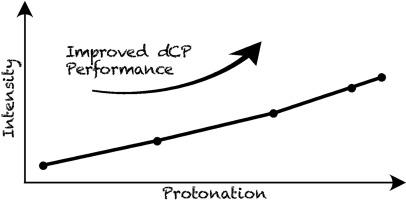Solid State Nuclear Magnetic Resonance ( IF 3.2 ) Pub Date : 2021-10-16 , DOI: 10.1016/j.ssnmr.2021.101762 Stuart J Elliott 1 , Quentin Stern 1 , Olivier Cala 1 , Sami Jannin 1

|
A strategy of dipolar order mediated nuclear spin polarization transfer has recently been combined with dissolution-dynamic nuclear polarization (dDNP) and improved by employing optimized shaped radiofrequency pulses and suitable molecular modifications. In the context of dDNP experiments, this offers a promising means of transferring polarization from high-gamma 1H spins to insensitive 13C spins with lower peak power and lower energy compared with state-of-the-art cross-polarization schemes. The role of local molecular groups and the glassing matrix protonation level are both postulated to play a key role in the polarization transfer pathway via an intermediary reservoir of dipolar spin order. To gain appreciation of the mechanisms involved in the dipolar order mediated polarization transfer under dDNP conditions, we investigate herein the influence of the pivotal characteristics of the sample makeup: (i) revising the protonation level for the constituents of the DNP glass; and (ii) utilizing deuterated molecular derivatives. Experimental demonstrations are presented for the case of [1–13C]sodium acetate. We find that the proton sample molarity has a large impact on both the optimal parameters and the performance of the dipolar order mediated cross-polarization sequence, with the 13C signal build-up time drastically shortened in the case of high solvent protonation levels. In the case of a deuterated molecular derivative, we observe that the nearby 2H substituted methyl group is deleterious to the 1H→13C transfer phenomenon (particularly at low levels of sample protonation). Overall, increased solvent protonation makes the dipolar order governed polarization transfer significantly faster and more efficient. This study sheds light on the influential sample formulation traits which govern the dipolar order-controlled transfer of polarization and indicates that the polarization transfer efficiencies of deuterated molecules can be boosted and reach high performances simply by adequate solvent protonation.
中文翻译:

质子化调谐偶极序介导的 1H→13C 交叉极化用于溶解-动态核极化实验
最近将偶极级介导的核自旋极化转移策略与溶解-动态核极化 ( d DNP) 相结合,并通过采用优化的射频脉冲和合适的分子修饰进行改进。在d DNP 实验的背景下,这提供了一种将极化从高伽马1 H 自旋转移到不敏感13与最先进的交叉极化方案相比,C 自旋具有更低的峰值功率和更低的能量。局部分子基团的作用和玻璃化基质质子化水平都被假定为通过偶极自旋顺序的中间储存库在极化转移路径中起关键作用。为了了解d DNP 条件下偶极级介导的偏振转移所涉及的机制,我们在此研究了样品组成的关键特性的影响:(i)修改 DNP 玻璃成分的质子化水平;( ii )利用氘代分子衍生物。针对 [ 1-13 ] 的情况进行了实验演示C]乙酸钠。我们发现质子样品摩尔浓度对偶极序介导的交叉极化序列的最佳参数和性能都有很大影响,在高溶剂质子化水平的情况下, 13 C 信号建立时间显着缩短。在氘代分子衍生物的情况下,我们观察到附近的2 H 取代的甲基对1 H→ 13是有害的C 转移现象(特别是在样品质子化水平较低时)。总体而言,增加的溶剂质子化使偶极顺序控制的极化转移显着更快和更有效。该研究揭示了控制偶极顺序控制的极化转移的有影响的样品配方特征,并表明氘化分子的极化转移效率可以通过适当的溶剂质子化来提高并达到高性能。



























 京公网安备 11010802027423号
京公网安备 11010802027423号